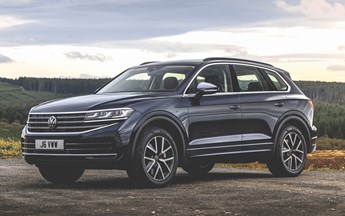We use cookies to ensure that we give you the best experience on our website. If you continue without changing your settings, we will assume that you are happy to receive all cookies on the Business Car website. However, if you would like to, you can change your cookies at any time

The start point for the best source of fleet information |
First drive: Volkswagen Touareg
Date: 19 December 2023 | Author: Sean Keywood

|
|
||||||||||||||||||||
Like most manufacturers, Volkswagen has introduced a comprehensive SUV range over the past couple of decades, but its flagship model remains the first of these - the Touareg, which debuted in 2002. The third-generation version arrived in 2018, and VW has now applied a mid-life facelift.
Engine options are a petrol, two diesels, and - of most interest surely to company car drivers - two plug-in hybrids, of which the (relatively) more modest 381hp version is tested here (a 462hp version comes with the Touareg R performance variant). The 381hp version pairs a 340hp petrol engine with a 136hp electric motor, while a 14.3kWh battery allows an EV-only range of up to 31 miles on the official WLTP combined cycle. Disappointingly for a plug-in hybrid, official CO2 emissions of more than 50g/km place this Touareg in the 15% company car BIK tax band - still much better than petrol or diesel versions, but high for a PHEV.
On the road, even though it's the less powerful of the two plug-in options, this powertrain still provides good acceleration for a large SUV. Unlike with many PHEVs, when worked hard the engine isn't noisy or intrusive at all (it's also quieter than a diesel Touareg), and what little note can be heard is a fairly pleasing growl. All Touaregs come with four-wheel drive as standard, and there is plenty of traction - our test drive on a fairly damp day produced no issues when needing a sharp getaway from a junction. The four-wheel drive system also allows a decent level of mud-plugging ability - on our test we conquered a fairly demanding off-road course with no problems.
As part of the facelift, VW's engineers have made adjustments to the Touareg's suspension, designed to improve comfort and agility. We wouldn't describe the ride as soft, but cabin occupants are very well insulated from potholes and other surface imperfections. Cornering produces a hint of body roll but there is no drama, and although you feel slightly removed from the driving process, the effect is relaxing rather than alarming.
Design changes with the facelift include a new horizontal illuminated strip in the radiator grille, and new alloy wheel designs. Unfortunately, one of the features VW is keenest to promote with the updated Touareg - HD LED matrix headlights - we were unable to assess during our daytime test drive.
Following the facelift, the plug-in hybrid option is now available for the first time with the entry-level Elegance version of the Touareg tested here. Despite its lowly position in the range, cabin trim is a high-quality mix of leather and gloss plastic, and everything feels well put together. An updated Innovision Cockpit set-up includes a 12in driver display and a 15in infotainment touchscreen, which looks impressive and has a good level of responsiveness, although the Touareg's screen-based climate controls are not the easiest to operate on the move.
There's loads of rear legroom, however with the standard sunroof, headroom for adults is no better than OK. Rear passengers do benefit from their own detailed climate controls as well as USB charge ports.
At 665 litres the boot is large - although not as large as with petrol and diesel Touaregs due to the hybrid battery - and seat-folding levers by the tailgate aid practicality.
We noted earlier that the Toureg's 15% BIK rate was disappointing, and this can be seen on comparison with plug-in hybrid versions of rivals such as the BMW X5 and Volvo XC90, which incur a rate of just 8%, making them far cheaper to tax for a company car driver. The VW is cheaper to buy than those two, however with the BMW and Volvo also expected to have stronger residual values and lower servicing costs, they should also prove cheaper to run on a cost-per-mile basis. It's an unfortunate flaw on the Touareg's part that drags down an otherwise fairly impressive SUV.
Volkswagen Touareg Elegance 3.0TSI eHybrid 4Motion 381 PS 8spd Tiptronic
P11D: £68,875
Residual value: 39.3%
Depreciation: £41,775
Fuel: £3,312
Service, maintenance and repair: £4,774
Cost per mile: 83.10p
Fuel consumption: 128.4mpg
CO2 (BIK %): 51g/km (15%)
BIK 20/40% a month: £172/£344
Luggage capacity: 665 litres
Engine size/power: 2,995cc/340hp plus 136hp electric motor
Verdict |
7/10 |
|||
 |
|
 |
|
|











